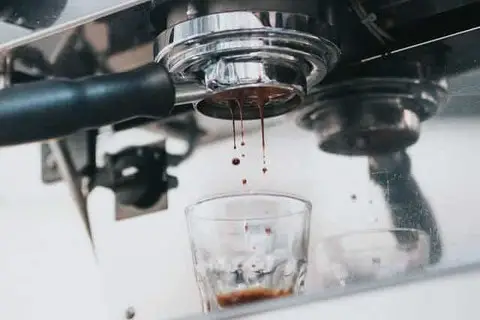As an Amazon Associate I earn from qualifying purchases. When you use our links, we may earn an affiliate commission. Learn more.
I had a friend who used to drive me insane. Whatever happened, he could never miss an espresso shot. I’ve never found one of his shots bitter, burnt, under-extracted, or over-extracted — not once! I was incredibly envious because he wasn’t experienced with coffee.
When I asked him, he finally revealed his secret — the pressurized portafilter!
In this post, I’ll explain “what is a pressurized portafilter” and everything about this ingenious tool. How does it work? What makes it unique? And why is it the best option for beginners? Let’s see!
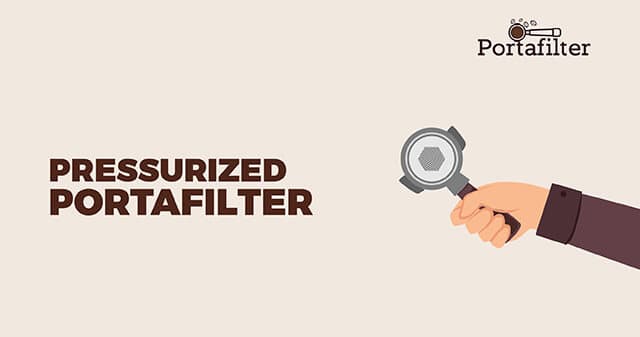
What is a Pressurized Portafilter?
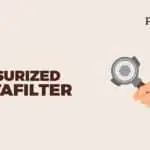
A pressurized portafilter is a portafilter with a small hole in the bottom of the basket, which creates a pressure build-up to force the coffee through the hole. A pressurized portafilter is also referred to as a “double-wall” portafilter.
Pressurized vs. Non-Pressurized Portafilter: What’s the Difference?

You won’t spot any difference if you look at pressurized and non-pressurized baskets from the top. They’re both circular and have the same depth. And they have dozens of tiny holes at the bottom screen.
However, you’ll instantly know what sets them apart when you flip them. In a non-pressurized portafilter, the tiny holes extend to the bottom surface as-is. The espresso will flow into your cup as soon as they pass through these holes.
When you flip a pressurized portafilter, you’ll see only one hole. Espresso will first pass through the tiny holes on the top screen, and then the flow will be tethered at the single hole in the bottom layer. Because there are two layers, pressurized portafilters are also known as “double-wall” portafilters — although “double-floor” would’ve been more accurate.
This free cheat sheet will improve your coffee brew by providing quick information on brew ratio, grind size, optimal brewing time, and more.
Why are pressurized portafilters better for beginners?
Pressurized portafilters are better for beginners because they are more forgiving concerning grind size and tamping. To better illustrate the benefits of a pressurized portafilter, we have to review how quickly a non-pressurized basket produces espresso.
The Non-Pressurized Process: Too Many Variables
When using a non-pressurized basket, the hot water first flows into the space above the puck. When the pressure builds up, it’ll start to flow through the grounds, extracting the flavorful compounds. Once it reaches the basket’s bottom, it’ll flow smoothly through the numerous holes.
To use this type of basket, you must be fairly experienced in making espresso. If the grind is too coarse, water will flow faster through the puck, leaving you with thin, under-extracted espresso.
If the grind is too fine, water will spend too much time contacting the grounds, leading to burnt, over-extracted coffee.
To make matters even worse, it’s not only about the grind size. You also have to perfect your tamping. If you don’t evenly distribute the grounds, water will pick the way with the least resistance, resulting in under or over-extraction.
The-Pressurized Portafilter: An Automated Process
In a pressurized basket, you don’t have to care much about the grind size or consistency. If the grind is too coarse, water will flow rapidly through the grounds, but it’ll instantly slow down once it reaches the single hole at the bottom. This way, the rest of the water can normally carry on the extraction process.
And, of course, every pressurized basket has a meticulous design that prevents the pressure from soaring up, which is why these baskets don’t usually produce burnt espresso.
As for the tamping, you should still do it to compress the coffee downwards and create enough clearance for the hot water. But the good news is, you don’t have to perfect the tamping direction — the pressurized system will automatically correct those mistakes.
If you want to give it a try, check out this guide on how to use a pressurized portafilter.
What are the disadvantages of pressurized portafilters?

Despite being convenient, the pressurized portafilters fall short of their non-pressurized counterparts in the following points.
They Restrict Your Grind Size
Pressurized portafilters can only work with coarse grinds. Why? Well, a fine grind will have a resistance of its own, especially if you tamp it well. Add that to the inherent pressure of the pressurized portafilters, and you’ll completely choke your machine!
But what’s wrong about coarse grinds, you might ask? Coarse grinds have less surface area than their fine counterparts. As a result, they yield less flavorful compounds, leaving you with thin espresso shots.
They Mess Up the Crema
As I said earlier, the non-pressurized portafilter allows the espresso to flow smoothly through the widescreen. This is one of the most important factors that allow the development of the perfect crema.
If you are unfamiliar, espresso crema should be full of flavor and aroma. It shouldn’t be too thin or too thick. And it should stay floating above your espresso for about 2 minutes.
No matter what you do, pressurized portafilters can never yield that crema. Because espresso gushes through an incredibly tiny hole, coffee oils emulsify and mix with too much air, leading to a crema that looks thick but tastes thin. And, of course, this crema will dive earlier into the shot, affecting the overall smoothness and lending a bitter taste.
You Can’t Fine-Tune Your Espresso
If you own a high-end espresso machine, using a non-pressurized portafilter will allow you to adjust everything — machine pressure, water temperature, grind size, dose, yield, and so forth.
With a pressurized model, you’ll be stuck with the default settings. If you try to pull an enhanced shot, the pressure system will either mess up your espresso or choke it completely.
Limited Extraction Rate
As I explained earlier, water will initially flow rapidly through the puck before it slows down at the pressure valve at the bottom of a pressurized portafilter.
As you might’ve guessed, this process will inadvertently detract from the espresso’s strength. You’ll pull a shot that’s more watery and less sweet than those made with a non-pressurized basket.
When should you use pressurized and non-pressurized portafilters?
To make sure you get the difference, I thought I should end this post with a quick comparison, explaining the ideal situations for pressurized and non-pressurized portafilters.
Use a Pressurized Portafilter If You Own an Entry-Level Grinder
If your grinder can’t achieve a consistent, fine grind, you’ll struggle with a non-pressurized portafilter.
The built-in valve of the pressurized model will make up for any discrepancies in the grind size. It can even allow you to use commercial pre-ground coffee.
Use a Pressurized Portafilter If You’re Short On Time
Don’t have enough time to perfect the tamping, dosing, temperature, and grinding? Set the machine on the default settings and go for a pressurized portafilter.
Even though this may not give you the ideal taste you crave, it’ll still be good enough on tight mornings when you can’t get by without espresso.
Use a Non-Pressurized Portafilter If You Know What You’re Doing
Do you know your way around an espresso machine? Well, don’t waste that priceless talent on a pressurized portafilter!
Get a non-pressurized model to adjust everything down to the smallest details.
Use a Non-Pressurized Portafilter If You Want the Best Espresso Shot Possible
If you want to enjoy a perfect crema on top of a strong, adequately extracted shot, a non-pressurized portafilter would be a no-brainer.
Do you tamp a pressurized portafilter?
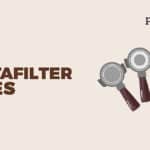
It’s not necessary to tamp a pressurized portafilter: tamping is crucial in a non-pressurized model because it’s the only thing that builds pressure inside the grounds, forcing the water to slow down and extract more flavor. In a pressurized portafilter, you already have a valve that controls this process.
Just press lightly to level the grounds and keep the group head clean.
How do you clean a pressurized portafilter?
Sprinkle some Cafiza Espresso Cleaning Powder in a large bowl filled with warm water. Throw the filter in there, and rinse it after about 5 minutes. Make sure to rinse well until you fully remove the slimy coat.
Conclusion
As you saw, pressurized filters aren’t that bad. I know the coffee community frowns upon them, but nobody can deny that they’re treasured for beginners. Remember to use a coarse grind because fine coffee will choke your machine.
Brooke Davis
Hi everyone, my name is Brooke and I’m a Barista and freelance writer. I love brewing coffee and my favorite coffee drink is without doubt an Americano (espresso with added hot water). When I’m not busy making or writing about coffee you’ll find me hanging out at the beach with friends in California where I am currently residing. Follow me on: LinkedinThis free cheat sheet will improve your coffee brew by providing quick information on brew ratio, grind size, optimal brewing time, and more.
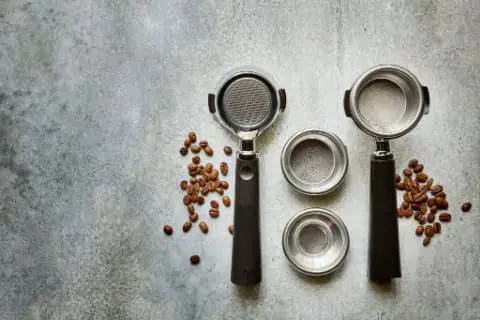
![Portafilter Size Chart [And BONUS Tamper Sizing Guide!]](https://portafilter.net/wp-content/uploads/2020/11/Portafilter-Size-Chart.png)
